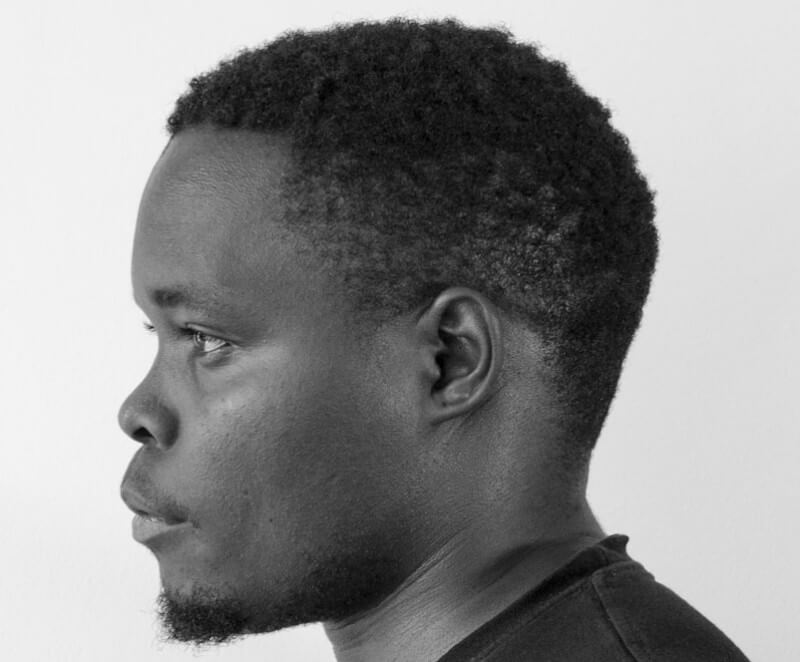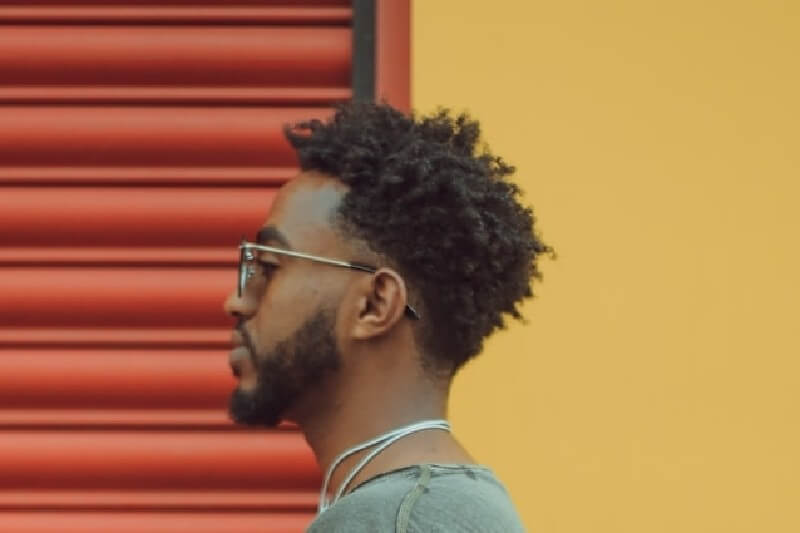If you’re a male reading this, hats off to you!
You’re part of the very few who care about black male hair types.
You see, understanding hair type isn’t just for women or people who spend hours in front of the mirror.
Knowing your hair type can make a big difference for guys, too.
It’s like knowing your shoe size or your favorite type of jeans – it helps you pick what works best for you.
So, let’s dive in and figure out what kind of hair you’ve got and how to take care of it like a pro.
Black Male Hair Types

Black male hair types range from wavy to kinky.
So, if you’re a black male, you have one or a mix of these hair types:
- Type 2 (wavy hair)
- Type 3 (curly hair)
- Type 4 (kinky or afro hair)
Most black males will have either curly or kinky hair.
Only 5.1% of Africans have wavy hair, but since it’s still a possibility, I counted it in!
Now, let’s talk about each of these black male hair types!
Type 2 Hair

Type 2 hair refers to wavy hair.
This hair type is neither straight nor curly; it’s somewhere in between.
Each hair strand is slightly bent, creating waves that could either be loose or tightly packed.
There’s a popular chart used to classify hair types — the Andre Walker hair chart — and it splits type 2 hair into three types:
- Type 2a: This type has very loose waves. In fact, it’s quite close to straight hair.
- Type 2b: This is the ideal wavy hair type — moderate waves that are not so loose or tight.
- Type 2c: 2c hair has tight waves, almost easy to mistake for loose curls. This hair type tangles the most among wavy hair types.
Check out more details about type 2 hair.
As mentioned, only a few black males have type 2 wavy hair.
Type 3 Hair

Type 3 hair is curly.
It is usually full and can have a fine or medium texture.
Most African-Americans have this hair type.
Black males with curly hair have either of these three hair types:
- Type 3a: This type has large, loose curls and is easy to mistake for tight waves. The hair is usually shiny.
- Type 3b: 3b has tighter curls. It is thicker than 3a.
- Type 3c: Here, you have very tight, full, and dense curls. You’ll find 3c hair easier to comb when it’s damp or moisturized. Otherwise, it can be a hassle.
Check out more details about type 3 hair.
Type 4 Hair

Black males with this hair type have tightly coiled or kinky hair.
When short, hair strands look like tight, round springs.
When short, hair strands look like tight, round springs.
Type 4 hair is common among Nigerians, Ghanaians, Kenyans, and other Africans.
It could either be:
- Type 4a: Tight coils that are clearly defined (you can see the shape of each strand easily). This type retains moisture well.
- Type 4b: Z-shaped coils that are a bit less defined. This type is more prone to dryness.
- Type 4c: The tightest curl pattern! It lacks definition and is highly prone to shrinkage and dryness. This type needs the most moisture and gentle care to avoid breakage.
Check out details about type 4 hair.
Vela Tip: It is very possible to have a mixture of hair types on one head. In fact, most people do!
How to Identify Hair Type in Short Male Hair
The usual method for identifying hair types is to pull out a strand and check the shape under clear light.
Then, you can know if it’s straight (type 1), wavy (type 2), curly (type 3), or kinky (type 4).
You can also see where it falls between the three subsections of each hair type.
But for male hair, which is usually short, here’s the trick:
Sorry, there’s no trick.
You’ll just have to let your hair grow to about one inch, then pull out a strand to check.
One inch is not a lot, so you may only need to postpone your next haircut by a few weeks to get it.
Since the hair type growing out of your scalp will never change, you only need to make this little sacrifice once. And the result — identifying your hair type — is worth it.
Speaking of which…
Why is it important to know your hair type?
Understanding your hair type, as a guy, helps you pick what works best for you in terms of hair care.
Not sure you agree? I’ll explain a little more.
Better Hair Care Choices
Not all hair products are created equal.
By knowing your hair type, you can choose shampoos, conditioners, and styling products that actually work for your hair instead of wasting money on stuff that leaves you looking like you just walked through a wind tunnel.
Easier Styling
Different hair types behave differently.
Knowing your hair type can save you a lot of frustration and time in the morning.
Whether your hair is curly, wavy, or kinky, you’ll know exactly how to style it so you look sharp with minimal effort.
Preventing Damage
Using the wrong products or styling techniques can cause serious damage to your hair.
Knowing your hair type helps you avoid common pitfalls like overwashing, using too much heat, or applying products that dry out your hair.
For example, when you know you have 4c hair (dry, fragile), you’ll know that your hair needs moisture (conditioners) and hydration (water) regularly to look healthy and shiny.
Boosting Confidence
Let’s face it: when your hair looks good, you feel good.
Understanding your hair type and how to care for it can boost your confidence, making you look and feel your best every day.
Caring for Different Black Male Hair Types
So, knowing your hair type helps you pick what works best for your hair, right?
But the journey isn’t complete if you just know your hair type; you also need to know what works for your hair type.
Here’s how to care for each black male hair type.
How to Care for Type 2 Black Male Hair Type
Type 2 (wavy) hair is fine and not as thick as other black male hair types. For this hair type:
- Focus on lightweight products to enhance your waves without weighing them down.
- Avoid heavy creams and oils.
- Use volumizing hair products if you want to give your hair more body.
How to Care for Type 3 Black Male Hair Type
Type 3 (curly) hair may tangle easily or feel dry. For this hair type:
- Moisturize your hair often with leave-in conditioner and water.
- To enhance your hair look, use curl-enhancing hair products.
- Avoid heavy hair butters because they may weigh down your curls, making them look flat.
How to Care for Type 4 Black Male Hair Type
Type 4 (kinky or afro) hair is very prone to breakage. It can be hard to comb, especially when full. For this hair type:
- Moisturize your hair daily with leave-in conditioner or water.
- Use heavy creams, butters, and oils to seal moisture in your hair.
- If it suits your preference, do protective styles like braids and twists to minimize breakage.
Frequently Asked Questions About Black Male Hair Types
Do you still have questions about black male hair types?
I’ve answered some common questions below!
What type of hair do black males have?
Black males majorly have curly (type 3) or kinky (type 4) hair.
Very few black males have wavy (type 2) hair.
What are the 4 types of hair men?
The four types of hair in men are straight (type 1), wavy (type 2), curly (type 3), and kinky (type 4).
It is the same as the types of hair in women.
What is 4c hair type in men?
4c hair type is the coilest type of hair.
It is commonly found among Africans, both male and female.
What is 4a, 4b, 4c hair type?
4a, 4b, and 4c all refer to kinky hair, that is, hair with tight coils.
The letters a, b, and c are used to describe how kinky they are.
4c is the most common among Nigerians.
Is black male hair types different from black female hair types?
No, gender does not determine hair types.
The lengths and style may differ, but hair type classifications are not different in males and females.
Hair Type Kings
Knowing your hair type is a game changer.
It boosts your confidence, helps you make smarter hair care choices, and keeps your hair looking its best.
As a guy, that makes you a “Hair Type King.”
There’s one more perk:
If anyone asks now, you can confidently tell them the difference between type 2, type 3, and type 4 hair.
And knowledge, they say, is power!